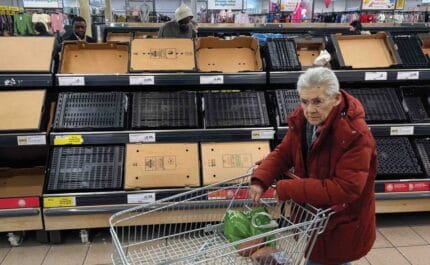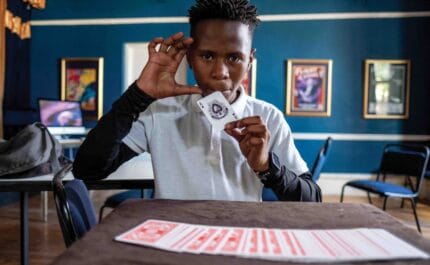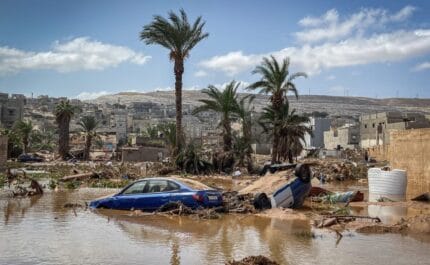The outpost
When Nancy Pelosi visited Taipei in August an infuriated China sent warplanes and ships into the Taiwan Strait, reasserting its claim over what it sees as a breakaway province. It also flew drones over the tiny but strategically significant Kinmen islands, the farthest-flung piece of Taiwanese territory, located just off China’s coast. Photographer An Rong Xu tells us about life in Kinmen, which could be the first battleground in a Chinese invasion of Taiwan

A tiny islet, part of the Kinmen islands, is pictured with the Chinese city of Xiamen in the background. The Kinmen islands are Taiwanese territory, but lie just off the coast of mainland China. Photo: An Rong Xu
5th August 2022 (Taken from: #48)
In 1949 Chiang Kai-Shek’s nationalist forces were fleeing mainland China, pursued by the communist People’s Liberation Army. They headed for sanctuary on a series of islands off the coast including Taiwan, where they installed the government of the Republic of China. Determined to crush their rivals for good, the communists launched a force of 9,000 troops to face them on Kinmen, a group of small islands separated from the mainland by just two miles of water.
It was here, on 25th-27th October 1949, that the nationalist forces won the Battle of Guningtou, bringing an end to the immediate prospect of communist invasion and producing an uneasy, antagonistic stalemate which has held for the last 73 years. As many as 5,000 soldiers perished on and around the landing ground in just three days. “Guningtou was one of the bloodiest battles at that time,’’ says An Rong Xu, a Taipei and New York-based photographer with family links to Kinmen through marriage. “The beach where it was fought is considered to be haunted, nobody goes there. It’s still full of rusting anti-landing spikes, you feel a tingle down your spine when you walk onto it. And then you walk about the quiet little towns and for the most part, it just feels like a very old world.” While Kinmen has remained frozen in the past, however, China has undergone rapid development – and the islanders now look out across the bay at a wall of glittering skyscrapers in the modern Chinese city of Xiamen.
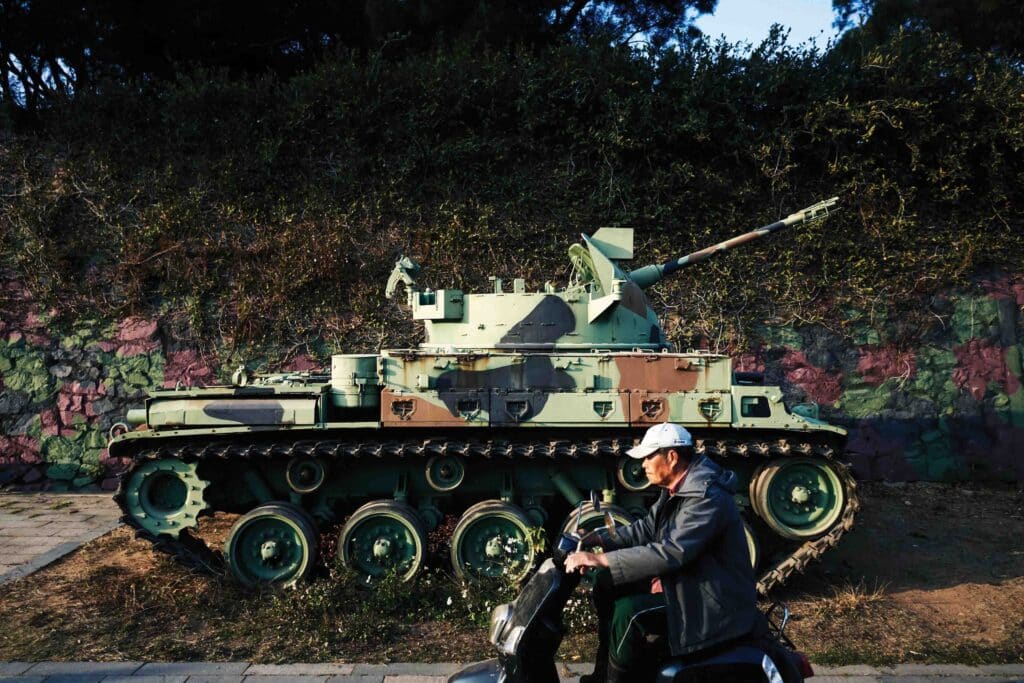
A man rides a scooter past a decommissioned tank on Lieyu, an outlying island of Kinmen that is the closest point between Taiwan and China. Photo: An Rong Xu
The Battle of Guningtou is memorialised at its own museum on Kinmen, in paintings Xu describes as depicting “an epic battle between good and evil”. It’s just one of a series of military-focused attractions on the islands alongside the August 23 Artillery Battle Museum and the Landmine Museum, where fake landmines startle visitors by emitting loud bangs when they walk by. “The Kinmen islands stand as a relic of war, you still have a lot of old tanks everywhere and a strong military presence,” says Xu. “You’re walking around where bombs used to drop, where people lived in constant fear during the Taiwan Strait Crises in the 1950s, when China bombed Kinmen nonstop for weeks at a time. People were forever [emotionally] scarred by that.”

A visitor looks at a painting depicting the fierce 1949 battle of Guningtou, at the Guningtou Battle Museum on Kinmen. Photo: An Rong Xu
Kinmen’s landscape has been shaped by the ongoing standoff between China and Taiwan. On the coast of the largest island stands a huge concrete tower filled with loudspeakers known as the Beishan Broadcast Wall, erected in 1967. “Those speakers used to be on full blast directed at Xiamen. They would play the voice of Teresa Teng, the darling of Mandarin pop, broadcasting propaganda towards the communist side,” says Xu. “She would say ‘Hello friends over in China, this is your colleague Teresa Teng. I am speaking to you from Kinmen where I’m enjoying freedom and democracy. I really hope you can come join me over here one day.’ And then they’d play one of her famous songs on loop.” Similar speakers were set up on the communist side to play retaliatory messages. Beishan still broadcasts today, albeit at a much lower volume, and just for tourists.
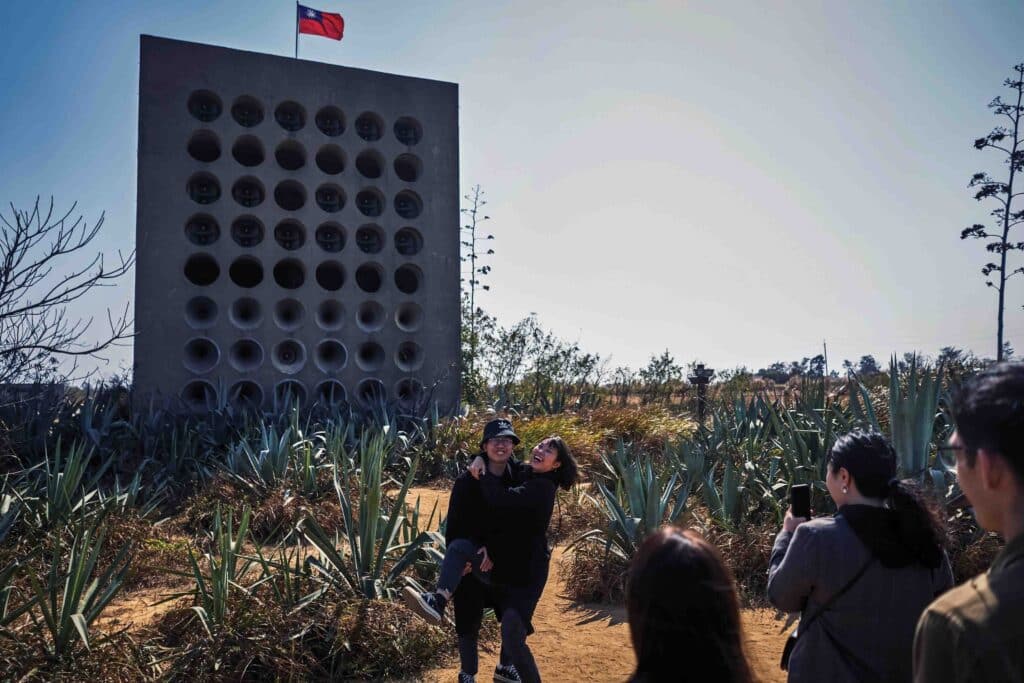
Tourists visit the Beishan Broadcast Wall, a structure built in 1967 for cross-strait propaganda warfare. Photo: An Rong Xu
Despite being no bigger in overall size than Sheffield, in 1958 the Kinmen archipelago became a potential flashpoint for World War III. During the Second Taiwan Strait Crisis that year, the People’s Liberation Army fired half a million shells at the islands. John Foster Dulles, the US secretary of state, saw Kinmen as a vital line of defence against a communist takeover of Taiwan. He drew up plans to defend the islands using conventional forces, the US navy’s seventh fleet was readied for action and the use of atomic weapons was seriously considered. When Soviet premier Nikita Khrushchev got involved, threatening the US on behalf of China, it seemed possible that Kinmen could spark a nuclear conflict.
Eventually the confrontation was de-escalated and the nervy status quo re-established, with the two sides coming to a strange accommodation. “They would shell each other at specific agreed locations on alternate days,” says Xu. This kept damage to a minimum while reiterating the belligerents’ mutual enmity. “At one point [the communists] started running out of actual artillery shells,” says Xu, “so they would shoot shells filled with propaganda flyers.” The arrangement was brought to an end in 1979, the same year that the US recognised Beijing as the sole legal government of China.
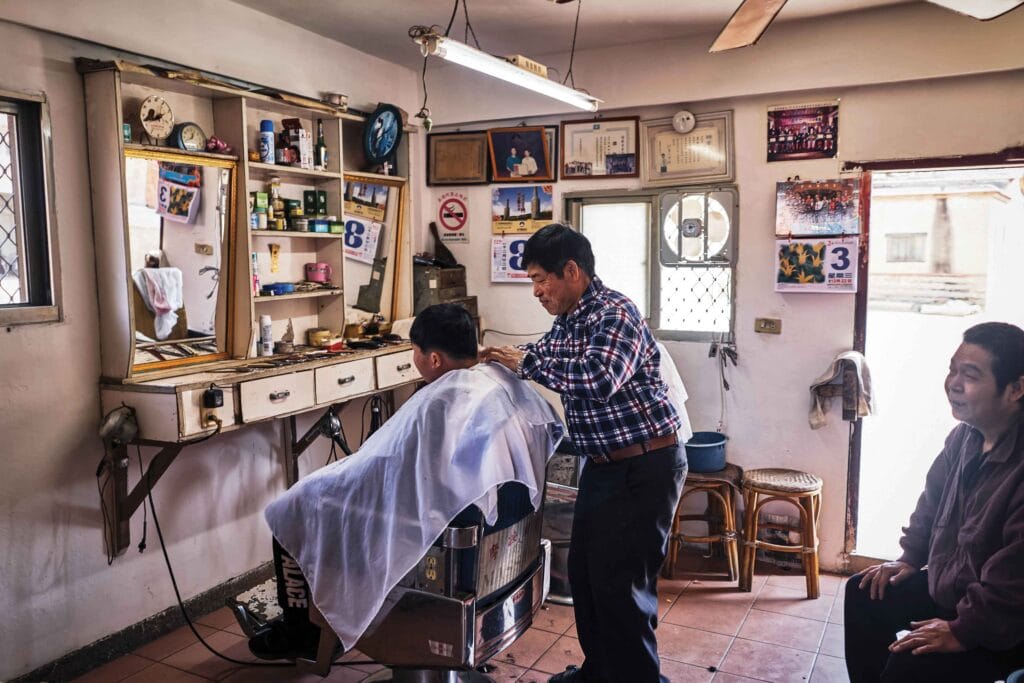
Daily life at a barber shop in Kinmen, Taiwan. Photo: An Rong Xu
War also spurred the creation of Kinmen’s modern industries. “The islands’ biggest product is Kinmen Kaoliang Liquor, which was created by nationalist soldiers,” says Xu. “There was a general who said, ‘Look, if we’re going to have soldiers on these islands, they need to be able to get drunk.’” Some soldiers were found who had a background in making spirits and they created a version of kaoliang, made by fermenting sorghum, which is now considered the national drink of Taiwan. “Apparently it tastes like rubbing alcohol but they say you don’t get hangovers when you drink it,” says Xu. “Residents of Kinmen get guaranteed regular deliveries of the stuff as a perk of being a citizen.”
Another industry is the repurposing of old munitions. “A man on Kinmen called Wu Tseng-dong thought, ‘Here are all these bombshells the communists have shot at us, what am I going to do with this steel?’” says Xu. “‘I’m going to reforge it and turn it into knives’.” Maestro Wu knives are now highly sought after, with his ‘bombshell steel’ set of a cleaver, chef knife and fruit knife retailing for US$425.
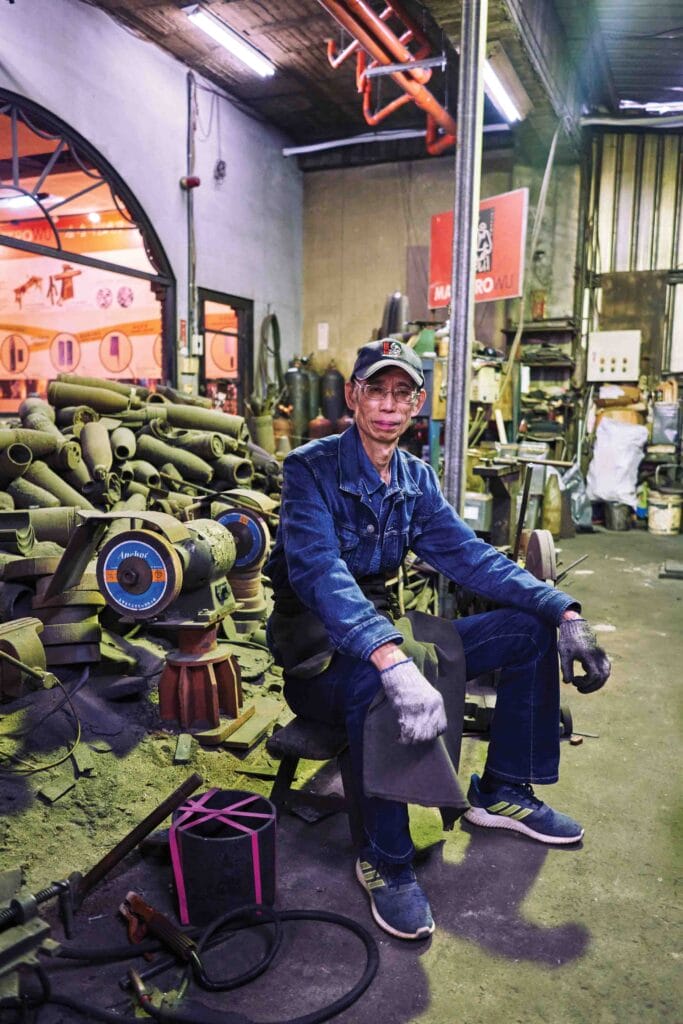
Wu Tseng-Dong, known as Maestro Wu, who reforges steel from some of the hundreds of thousands of shells that have been launched at Kinmen, turning it into high quality kitchen knives. Photo: An Rong Xu
Some of the islands’ military infrastructure has found new uses in the 21st century. “There’s a network of tunnels under Kinmen, including one with a post where you can see China directly at the end,” says Xu. “Soldiers used to run back and forth here to observe the mainland and communicate their findings, and when they got a new shipment of bombs from Taiwan they would take it through these tunnels.” Nowadays they have a new cultural role. “They’ve actually started using some of the Zhaishan tunnels, which have water running through them, as performance spaces because the acoustics are so great,” says Xu. “They’ll put the band on a float, like a raft and then put them out in the middle of the tunnel to perform; the concert tickets sell out really quickly.”
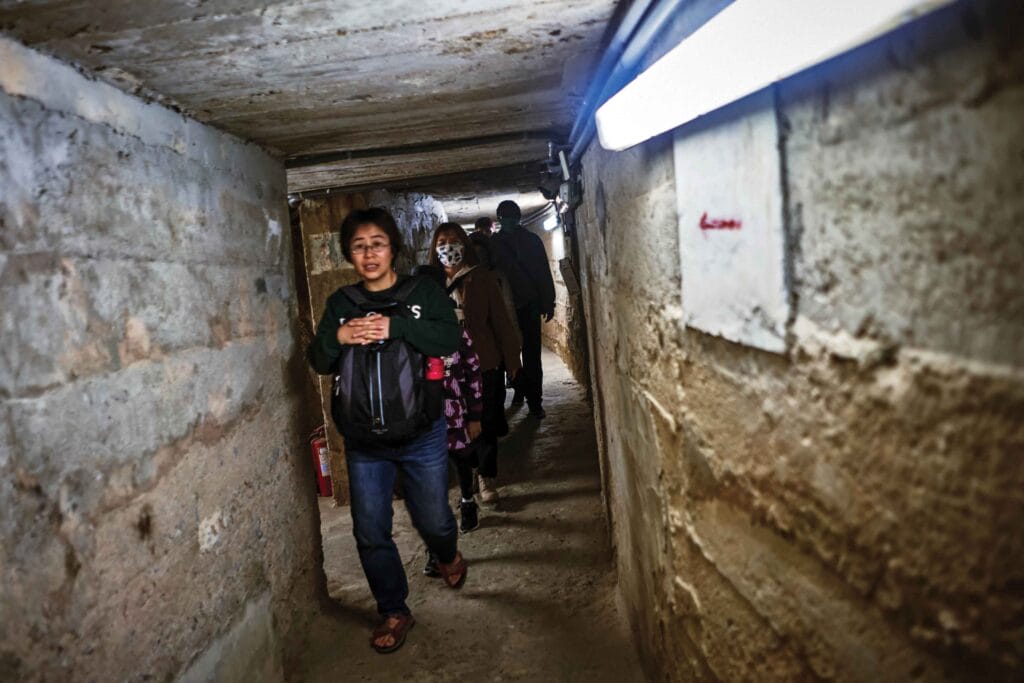
Tourists visit the tunnels beneath the Shaxi Fort in Lieyu, Kinmen. Photo: An Rong Xu
Tourists were drawn to the concerts in pre-pandemic days, including mainland Chinese, Kinmen being one of the few parts of Taiwan they can visit without a visa. It’s not the only link between the two sides – in 2001, transportation, post and trade were allowed between Kinmen and China in a policy called ‘three small links’, which helped create an economic boom in the islands.

Tourists stand at the base of a memorial that commemorates the 1958 Second Taiwan Strait Crisis in Lieyu, one of the Kinmen islands. Photo: An Rong Xu
“Much of the water on Kinmen comes in a pipe from China, as well as a lot of electricity,” says Xu, referring to the Jinjiang–Kinmen Pipeline, which started delivering supplies from the Longhu Lake in the mainland province of Fujian in August 2018. “That’s the Chinese way – like the Belt and Road Initiative, everything is about creating a reliance on China. The Kinmen government allowed it to happen because they needed it, especially during the droughts [which have affected the island since the mid-’90s]. And that’s why a lot of folks on Kinmen feel a disassociation with the Taiwanese mainland, because it seems like China does more for them than Taiwan does.” Kinmen has been heavily reliant on imports from China, and Taiwanese businessmen have used Kinmen as a way to access the markets of the Chinese mainland.
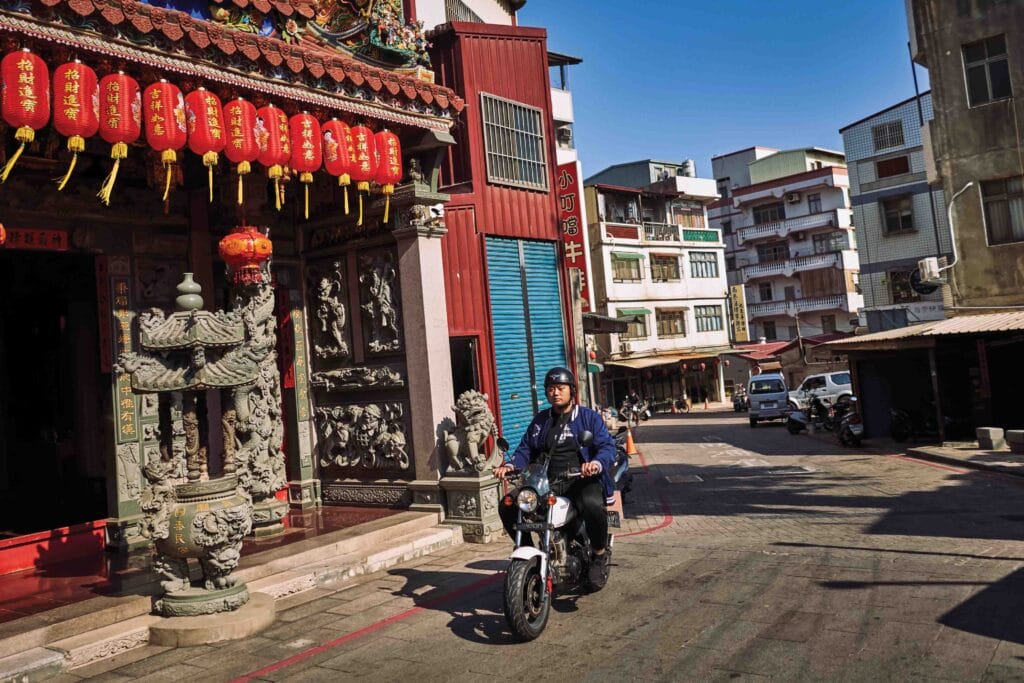
A man rides along a street in Kinmen, Taiwan. Photo: An Rong Xu
“A lot of people in Kinmen actually have an inferiority complex too, because right across from them, you’re literally looking at a modern city with these giant towers and this beautiful cityscape. Many people say ‘They’re not going to attack us, there’s no point in attacking us, we have nothing here,’” says Xu.
The ‘three small links’ policy was ended by Taipei in February 2020 in the wake of the spread of Covid-19 and has not yet been reinstated, and Kinmen’s economy has taken a major hit in the last two years. Tensions between Taipei and Beijing remain high in the wake of Nancy Pelosi’s visit in August. Chinese president Xi Jinping told President Biden at their meeting at the G20 summit in November 2022 that the question of Taiwan’s status was the “first red line” that the US must not cross, and Biden criticised China’s “coercive and increasingly aggressive actions toward Taiwan, which undermine peace and stability across the Taiwan Strait.” In one positive step, however, it was agreed that climate talks between Washington and Beijing that were frozen by China after Pelosi’s visit will resume.
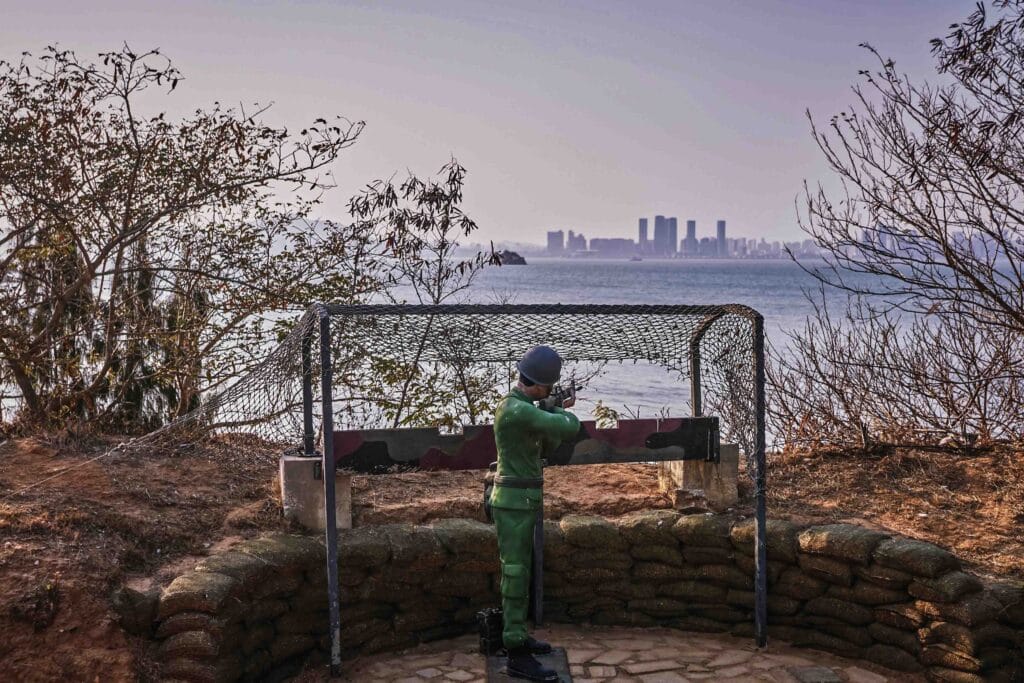
A figure of a soldier stands in a historic fort in Lieyu, Kinmen. Wartime anti-tank barricades litter Kinmen’s beaches and Lieyu is home to the Zhaishan tunnel, which Taiwanese forces reserve the right to use in wartime and for military exercises. Photo: An Rong Xu
As many as 20,000 Taiwanese troops remain on Kinmen, and it seems likely that any attempted invasion of the islands would be bitterly resisted by Taipei. These days, however, there’s a certain fatalism among some of Kinmen’s residents, as well as a weariness with the longstanding threats from the mainland. “Many of the young people that I’ve spoken to have said ‘If the Chinese do attack, there’s nothing we can really do. It’s not something that’s in our hands,’” says Xu. “And I saw an old man interviewed on the news, they asked him, ‘Are you scared?’ He said ‘They’ve been threatening us since I was a kid. I’m 83 now. So you tell me if I’m scared.”
See more of An Rong Xu’s work here
Slow Journalism in your inbox, plus infographics, offers and more: sign up for the free DG newsletter. Sign me up
Thanks for signing up.
